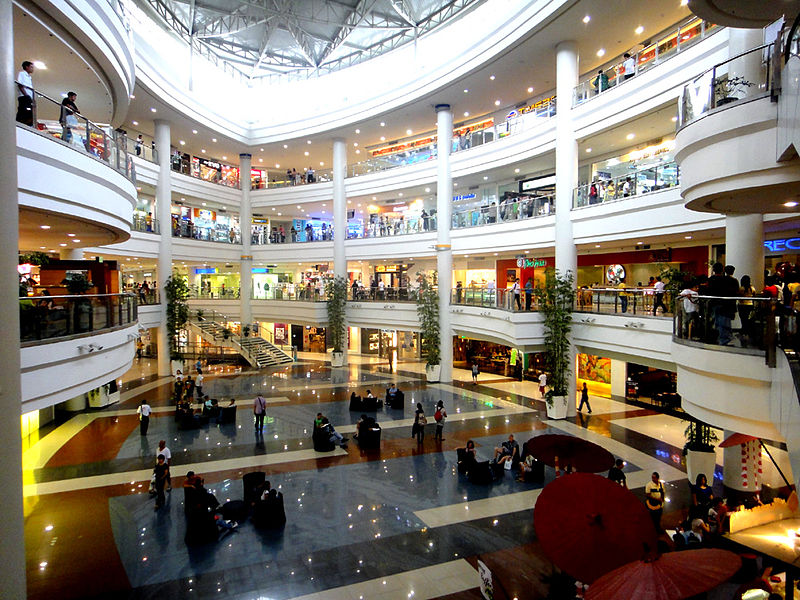by Dan Geddes
15 March 2000
Converting shopping malls into prisons is a cost-effective way to create prison space to house America’s growing population of non-violent criminal offenders.
America has an undisputed need for prison space, as we keep more than two million people behind bars. The tendency of courts to coddle prisoners makes the cost of housing criminal offenders mount inexorably.
By a happy coincidence, America’s stock of shopping malls is aging ungracefully. Malls built during the shopping mall’s gold rush days of the 1970s are now depressing environments, plagued by empty stores and roamed by unkempt hooligans. Efforts to convert these malls into community centers are usually ineffective, and an increasing number of these malls—some less than twenty years old—are being razed because they no longer appear to serve any purpose. This is a tragic fall from the vital civic function they once served.
Why not use these cavernous malls to satisfy our government’s need for more prison space? It is not so far-fetched once you consider it. Shopping malls tend to be huge, windowless, concrete structures. They feature adjoining parking lots that provide ample room for recreation yards and for buffers between the prison and nearby suburban populations, who wish to keep these convicts at bay.
Refitting a shopping mall into a prison takes surprisingly little effort. The inmates could be housed in the stores themselves. A former shoe store, for example, can house up to fifty inmates comfortably. All stores are already equipped with a metal gate for their front doors. The gate can be pulled down and locked to keep the prisoners inside. And with some “poetic justice,” shoplifters can be confined in the very stores in which they once practiced their craft.
At meal times, prisoners can visit a centrally located food court, where extensive kitchen facilities are already in place.
Malls are already designed to hold people in place for the maximum period of time. Consider the design of the parking lots. Special zoning permissions already allow nearby traffic lights to remain constantly green in order to allow people to enter the mall (or prison), while persistently red lights obstruct the exits. Guard posts erected at these bottlenecks would make escape very difficult.
“It’s a Mall World After All”
Although simply using shopping malls as prisons could save taxpayers millions of dollars in new prison construction costs, creative incarceration programs could lead to lower operational costs of running the prisons, as well boost our economy by encouraging prisoners to be full-fledged consumers.
The number of guards needed to man a prison is a decisive factor in its operational costs. However, many studies have shown that if prisoners are suitably occupied, then their idle brains do not hatch plans to escape. As expected, installing televisions in prison cells, especially cable television, has led to such atrophy of mind and spirit among the prisoners that guards were scarcely needed in those prisons. Granting unlimited internet access to prisoners will also render many prisoners sedentary and supine, just as with “couch potatoes” and internet addicts in the general population.
Keep in mind that thousands of inmates are non-violent, and serve time only for such crimes as recreational drug use or political dissent. These non-violent offenders can participate in the pilot program.
Let’s call it “It’s a Mall World After All.” The shops in the new prison malls are reopened, but are staffed entirely by prisoners! Constant video surveillance prevents theft. Video surveillance technology is already in such widespread use in shopping malls that equipment upgrade costs are minimal.
At night prisoners can sleep in the stores in which they work, making sure to first lock themselves in with the metal gates already in place. The stores are open every day from 6:00 a.m. to 10:00 p.m. (until 11:00 p.m. during the week before Christmas), and prisoners are scheduled to work ten hours per day.
For their labors, each prisoner is allotted a $10,000 voucher per year to spend in the shops, where the prices are dramatically inflated to match those found in airports or amusement parks. After their ten-hour day work, they have four hours per day with which to shop. The schedules are arranged so that there are always non-violent offenders shopping.
Remember that states currently spend an average of $40,000 per year to incarcerate one prisoner. Under the “It’s a Mall World After All” plan, we estimate a savings of $5,000 dollars per prisoner, even after granting each prisoner an allowance of $10,000.
Here’s how:
- * a $5,000 per prisoner savings in new prison construction costs;
- * a $5,000 per prisoner savings in prison guards. A few machine-gun wielding guards can be placed in skylights and at the mall exits, nearly all of which can be blocked off with giant dumpsters containing the waste generated by the mall prison;
- * a $3,000 per prisoner subsidy paid by the merchants, taken from the store’s profits;
- * a $2,000 per prisoner savings in food costs, as prisoners are required to feed themselves at the food court out of their $10,000 allowance.
Assuming the $40,000 currently being spent to keep an inmate in jail, this would save the government $15,000 per prisoner. The $10,000 allowance given to the prisoners pays for itself through lower costs, and by creating a more robust prison economy.
With 400,000 non-violent offenders behind bars, that’s a savings of $2 billion per year. Part of the $2 billion should be earmarked to fight the War on Drugs and put even more non-violent drug offenders into the “It’s a Mall World After All” program.
And consider the more meaningful lives the prisoners can lead! After a leisurely morning of shopping or browsing, the inmates could visit the food court for lunch. The lunch served at food courts is perhaps more perilous to their health than the fare served at most prisons. Thus, the prisoners’ consumption of cheeseburgers, soda, and sweetened coffee will probably decrease their life-spans in incarceration, leading to further cost savings. But making their own unhealthy dietary choices validates the prisoners’ self-esteem, giving them the same illusion of consumer freedom as people outside the prison malls.
After lunch, the shopping continues. Or perhaps the prisoners choose to take in a movie. The inmates could prove a captive audience at the cinemas for Hollywood’s latest spectacle, providing important focus group feedback in exchange for free movie passes and popcorn.
Credit card companies will certainly take note of this new demographic cluster with secure incomes and infinite time to shop, and so inundate the prisons with credit card applications, albeit with higher interest rates. They will set up booths to encourage passers-by to sign up—and the credit card companies can easily verify the applicant’s address. The existing dental and optical centers in malls could be utilized to service the prisoners.
Note that with $10,000 in hand to spend in a fully stocked shopping mall, prisoners would have little incentive to leave, and so security costs would be streamlined. To prevent any black market from arising and breeding gangs, a few shops would be dedicated to serving the prisoners’ needs for such vices as cigarettes and soft drugs. Certainly inmates who have smoked some marijuana, and then ambled into a novelty store will become fixated on the available merchandise, and will lack the motivation or will to attempt escape. Prisoners who develop an entrepreneurial knack could also open a few bordellos, knowing that a steady business is theirs for the asking.
Willing prisoners can even sign-up for the “Shop Until you Drop” plan, whereby they forego their rights to appeal, parole, probation, health care, and counseling, in exchange for an additional credit-line of $5,000 per year.
The prisoners will feel much more a part of normal society, and so will be less vengeful and more easily assimilated if they ever rejoin society at large. From their extensive experience in shopping malls, they will have gained the social skills needed to find a place in society, and perhaps a job as a cashier, unless cashier jobs have all been automated away by that time.
A chief criticism against this proposal is that life inside the prison walls is so appealing that more people would want to go to prison. After all, it seems little different from the lives of the people on the outside, except that their commute to their deadening wage-slave jobs is much shorter than the commute of wage-slaves still on the outside.
But this is an unconvincing critique of the proposal, as there is little danger that many people would deliberately commit non-violent crimes just to be allowed to live in the prison malls. The $10,000 yearly income is simply too small to satisfy most people’s needs for cheaply made consumer products that are often disposed of almost immediately after being purchased. Most people would rather work for more consumer goods, even if it means accruing back-breaking consumer debt as well.
A more convincing argument for this proposal is the profoundly beneficial impact it would have on our economy as a whole. The large and growing prison population, while it currently benefits a few companies with lucrative government contracts, is of little use to the economy at large. By transforming inmates with infinite time on their hands into dedicated shoppers or movie viewers, we can spur our economy into even more furious fits of consumption and growth.
And from that, we all benefit.
Dan Geddes is the editor of The Satirist. In addition to satire, Geddes’ serious criticism in The Satirist online has been widely cited in books, English courses, academic papers, newspapers, and websites. Geddes has written for the Cleveland Plain Dealer, the Dry Bones Review, and The Modern Word. His satirical work has also appeared in GlossyNews.com. He lives in Amsterdam.
















Be First to Comment